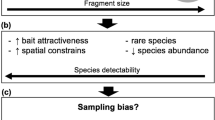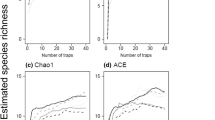Abstract
Pitfall trapping is a sampling technique extensively used to sample surface foraging invertebrates for biological diversity studies and ecological monitoring. To date, very few invertebrate studies have considered what trap size is optimal for sampling spiders. This study presents preliminary findings from a single short sampling period on the role of trap size in sampling spiders in a Western Australian Jarrah forest. Four different trap diameters (4.3, 7.0, 11.1 and 17.4 cm) were examined (4 trap sizes × 15 replicates = 60 traps). Two-way ANOVAs revealed no significant interaction effects between trap size or the spatial positioning of transects within the study site along which the pitfall traps were arranged. Post-hoc tests revealed abundance, family richness and species richness increased with increasing trap sizes for traps ≥7.0 cm. No significant differences in these dependent variables occurred between 4.3 and 7.0 cm traps, or for species richness between 11.1 and 17.4 cm traps. Determination of an optimal trap size was undertaken by bootstrapping and calculating species accumulation curves for increasing numbers of traps used. Three different criteria were considered: equivalent number of traps (15), standardized sampling intensity (cumulative trap circumference, approximately 207 cm) and standardized cumulative handling time (approximately 1 hour 17 minutes). The largest trap size (17.4 cm) was most efficient in terms of number of traps and trap circumference. For the same number of traps, it caught 19 species whereas all other trap sizes caught ≤ten species. At the standardized circumference, it caught seven species whereas all other trap sizes caught five. For handling time, however, the two largest trap sizes (17.4 and 11.1 cm) were optimal. Both caught nine species whereas all other traps caught <eight. These results suggest the largest trap size was optimal. Given that the 11.1 cm trap performed similarly with respect to handling time, however, we tentatively considered this size most appropriate owing to an ethical consideration – smaller trap sizes may decrease the potential for capture of non-target species.
Similar content being viewed by others
References
Abacus Concepts Inc. (1992) SuperANOVA. Berkeley, CA: Abacus Concepts Incorporated.
Abacus Concepts Inc. (1996) StatView 4.5. Berkeley, CA: Abacus Concepts Incorporated.
Abensperg-Traun, M. and Steven, D. (1995) The effects of pitfall trap diameter on ant species richness (Hymenoptera: Formicidae) and species composition of the catch in a semi-arid eucalypt woodland. Aust. J. Ecol. 20, 282–7.
Anon. (1993) Foreword. In Rapid biodiversity assessment: Proceedings of the biodiversity assessment workshop, 3-4 May 1993, Macquarie University, Sydney, Australia (A.J. Beattie, ed.), pp. 1–2. Sydney: Research Unit for Biodiversity and Bioresources, School of Biological Sciences, Macquarie University.
Beattie, A.J., Majer, J.D. and Oliver, I. (1993) Rapid biodiversity assessment: A review. In Rapid biodiversity assessment: Proceedings of the biodiversity assessment workshop, 3-4 May 1993, Macquarie University, Sydney, Australia (A.J. Beattie, ed.), pp. 4–14. Sydney: Research Unit for Biodiversity and Bioresources, School of Biological Sciences, Macquarie University.
Churchill, T.B. (1993) Effects of sampling methods on composition of a Tasmanian coastal heathland spider assemblage. Memoirs of the Queensland Museum 33, 475–81.
Churchward, H.M. and Dimmock, G.M. (1989) The soils and landforms of the northern Jarrah forest. In The Jarrah Forest (B. Dell, J.J. Havel and N. Malajczuk, eds) pp. 13–22. London: Kluwer Academic Publishers.
Coddington, J.A., Griswold, C.E., Davila, C.E., Penaranda, D.S. and Larcher, S.F. (1991) Designing and testing sampling protocols to estimate biodiversity in tropical ecosystems. In The unity of evolutionary biology: Proceedings of the fourth international congress of systematic and evolutionary biology (E.C. Dudley, ed.) pp. 44–60. Portland: Dioscordes Press.
Coddington, J.A., Young, L.H. and Coyle, F.A. (1996) Estimating spider species richness in a southern Appalachian cove hardwood forest. Ann. Rev. Ecol. and Syst. 24, 111–28.
Colwell, R.K. and Coddington, J.A. (1994) Estimating terrestrial biodiversity through extrapolation. Philosoph. Transact. Royal Soc. of London B 345, 101–18.
Curtis, D.J. (1980) Pitfalls in spider community studies. J. Arach. 8, 271–80.
Day, R.W. and Quinn, G.P. (1989) Comparisons of treatments after an analysis of variance in ecology. Ecological Monographs 59, 433–63.
Greenslade, P.J.M. (1964) Pitfall trapping as a method of sampling populations of Carabidae (Coleoptera). J. Anim. Ecol. 33: 301–10.
Hammond, P.M. (1994) Practical approaches to the estimation of the extent of biodiversity in speciose groups. Philosoph. Trans. Royal Soc. of London B 345, 119–36.
Koponen, S. (1993) Ground living spiders (Araneae) one year after fire in three subarctic forest types, Quebec (Canada). Memoirs of the Queensland Museum 33, 575–8.
Krajca, A. and Krumpálová, Z. (1998) Epigeic spider (Araneae) communities of nickel leach dumps and their surroundings near Sered' (Slovakia). Biologia Bratislava 53, 173–87.
Luff, M.L. (1975) Some features influencing the efficiency of pitfall traps. Oecologia 19, 345–57.
Main, B.Y. (1976) Spiders. Sydney: Collins.
Majer, J.D. (1997) The use of pitfall traps for sampling ants: a critique. Memoirs of the Museum of Victoria 56, 323–9.
May, B.M. (1963) New Zealand cave fauna. II. The limestone caves between Port Waikato and Piopio districts. Trans. of the Royal Soc. of N.Z. Zool. 3, 181–204.
Merrett, P. and Snazell, R. (1983) A comparison of pitfall trapping and vacuum sampling in four stands of Dorset heathland representing different growth phases of heather. Bull. Brit. Arach. Soc. 6, 14–22.
Simmonds, S.J., Majer, J.D. and Nichols, O. (1994) A comparative study of spider (Araneae) communities of rehabilitated bauxite mines and surrounding forest in the south-west of Western Australia. Restoration Ecology 2, 247–60.
Southwood, T.R.E. (1966) Ecological methods with particular reference to the study of insect populations. London: Methuen.
Specht, R.L. (1970) Vegetation. In The Australian Environment (G.W. Leeper, ed.), pp. 42–67. Melbourne: CSIRO and Melbourne University Press.
Strehlow, K.H. (1993) Impact on fires on spider communities inhabiting semi-arid shrublands in Western Australia's wheatbelt. Unpub. Hons. Thesis. Perth: Department of Biology, Murdoch University.
Topping, C.J. and Luff, M.L. (1995) Three factors affecting the pitfall trap catch of linyphiid spiders (Araneae: Linyphiidae). Bull. Brit. Arach. Soc. 10, 35–8.
Topping, C.J. and Sunderland, K.D. (1992) Limitations to the use of pitfall traps in ecological studies exemplified by a study of spiders in a field of winter wheat. J. Appl. Ecol. 29, 485–91.
Uetz, G.E. and Unzicker, J.D. (1976) Pitfall trapping in ecological studies of wandering spiders. J. Arach. 3, 101–11.
York, A. (1989) The response of ant communities to fireinduced habitat disturbance. Unpub. Ph.D. Thesis. Sydney: School of Biological Sciences, University of New South Wales.
Author information
Authors and Affiliations
Corresponding author
Rights and permissions
About this article
Cite this article
Brennan, K.E., Majer, J.D. & Reygaert, N. Determination of an Optimal Pitfall Trap Size for Sampling Spiders in a Western Australian Jarrah Forest. Journal of Insect Conservation 3, 297–307 (1999). https://doi.org/10.1023/A:1009682527012
Issue Date:
DOI: https://doi.org/10.1023/A:1009682527012




